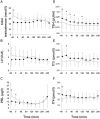Pituitary-gonadal and pituitary-thyroid axis hormone concentrations before and during a hypoglycemic clamp after sleep deprivation in healthy men
- PMID: 23326598
- PMCID: PMC3542327
- DOI: 10.1371/journal.pone.0054209
Pituitary-gonadal and pituitary-thyroid axis hormone concentrations before and during a hypoglycemic clamp after sleep deprivation in healthy men
Abstract
Total sleep deprivation (TSD) exerts strong modulatory effects on the secretory activity of endocrine systems that might be related to TSD-induced challenges of cerebral glucose metabolism. Here, we investigate whether TSD affects the course of male pituitary-gonadal and pituitary-thyroid axis related hormones during a subsequent 240-min hypoglycemic clamp. Ten healthy men were tested on 2 different conditions, TSD and 7-hour regular sleep. Circulating concentrations of total testosterone, prolactin (PRL), thyroid stimulating hormone (TSH), free triiodothyronine (fT3), and free thyroxin (fT4) were measured during baseline and a subsequent hypoglycemic clamp taking place in the morning. Basal, i.e. at 07:00 am measured, concentrations of total testosterone (P = 0.05) and PRL (P<0.01) were lower while the values of TSH (P = 0.02), fT3 (P = 0.08), and fT4 (P = 0.04) were higher after TSD as compared to regular sleep. During the subsequent hypoglycemic clamp (all measurements from baseline to the end of the clamp analyzed) total testosterone concentrations in the regular sleep (P<0.01) but not in the TSD condition (P = 0.61) decreased, while PRL levels increased (P = 0.05) irrespectively of the experimental condition (P = 0.31). TSH concentrations decreased during hypoglycemia (P<0.01), with this decrease being more pronounced after TSD (P = 0.04). However, at the end of the hypoglycemic clamp concentrations all of the above mentioned hormones did not differ between the two sleep conditions. Our data indicate a profound influence of TSD on male pituitary-gonadal and pituitary-thyroid axis hormones characterized by reduced basal testosterone and PRL levels and increased TSH levels. However, since concentrations of these hormones measured at the end of the 240-min hypoglycemic clamp were not affected by TSD it can be speculated that the influence of TSD on the two endocrine axes is rather short lived or does not interact in an additive manner with their responses to hypoglycemia.
Conflict of interest statement
Figures

Similar articles
-
Acute and prolonged effects of insulin-induced hypoglycemia on the pituitary-thyroid axis in humans.Metabolism. 2002 Oct;51(10):1370-4. doi: 10.1053/meta.2002.35193. Metabolism. 2002. PMID: 12370861 Clinical Trial.
-
Pituitary and peripheral thyroid hormone responses to thyrotropin-releasing hormone during sustained sleep deprivation in freely moving rats.Endocrinology. 1995 Apr;136(4):1426-34. doi: 10.1210/endo.136.4.7895653. Endocrinology. 1995. PMID: 7895653
-
Experimental study on neuroendocrinological and immunological characteristics of the military-trained artillerymen.Chin Med J (Engl). 2012 Apr;125(7):1292-6. Chin Med J (Engl). 2012. PMID: 22613604
-
Partial sleep restriction modulates secretory activity of thyrotropic axis in healthy men.J Sleep Res. 2013 Apr;22(2):166-9. doi: 10.1111/jsr.12004. J Sleep Res. 2013. PMID: 23495953 Clinical Trial.
-
Acute neuro-endocrine profile and prediction of outcome after severe brain injury.Scand J Trauma Resusc Emerg Med. 2013 Apr 20;21:33. doi: 10.1186/1757-7241-21-33. Scand J Trauma Resusc Emerg Med. 2013. PMID: 23601250 Free PMC article.
Cited by
-
Sleep apnea syndrome associated with gonadal hormone imbalance (Review).Biomed Rep. 2023 Oct 25;19(6):101. doi: 10.3892/br.2023.1683. eCollection 2023 Dec. Biomed Rep. 2023. PMID: 38025832 Free PMC article. Review.
-
The relationship between thyroid function tests and sleep quality: cross-sectional study.Sleep Sci. 2021 Jul-Sep;14(3):196-200. doi: 10.5935/1984-0063.20200050. Sleep Sci. 2021. PMID: 35186196 Free PMC article.
-
Clamping Cortisol and Testosterone Mitigates the Development of Insulin Resistance during Sleep Restriction in Men.J Clin Endocrinol Metab. 2021 Aug 18;106(9):e3436-e3448. doi: 10.1210/clinem/dgab375. J Clin Endocrinol Metab. 2021. PMID: 34043794 Free PMC article. Clinical Trial.
-
Evaluating the Spectrum of Sleep Abnormalities in Patients With Primary Hypothyroidism.Cureus. 2024 Sep 21;16(9):e69855. doi: 10.7759/cureus.69855. eCollection 2024 Sep. Cureus. 2024. PMID: 39435197 Free PMC article.
-
Sleep, testosterone and cortisol balance, and ageing men.Rev Endocr Metab Disord. 2022 Dec;23(6):1323-1339. doi: 10.1007/s11154-022-09755-4. Epub 2022 Sep 24. Rev Endocr Metab Disord. 2022. PMID: 36152143 Free PMC article. Review.
References
-
- Klieverik LP, Coomans CP, Endert E, Sauerwein HP, Havekes LM, et al. (2009) Thyroid hormone effects on whole-body energy homeostasis and tissue-specific fatty acid uptake in vivo. Endocrinology 150: 5639–5648. - PubMed
-
- Bremner WJ (2010) Testosterone deficiency and replacement in older men. N Engl J Med 363: 189–191. - PubMed
-
- Boelaert K, Franklyn JA (2005) Thyroid hormone in health and disease. J Endocrinol 187: 1–15. - PubMed
-
- Krassas GE, Poppe K, Glinoer D (2010) Thyroid function and human reproductive health. Endocr Rev 31: 702–755. - PubMed
-
- Tanriverdi F, Silveira LF, Maccoll GS, Bouloux PM (2003) The hypothalamic-pituitary-gonadal axis: immune function and autoimmunity. J Endocrinol 176: 293–304. - PubMed
Publication types
MeSH terms
Substances
LinkOut - more resources
Full Text Sources
Other Literature Sources
Medical

